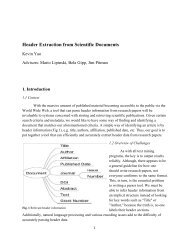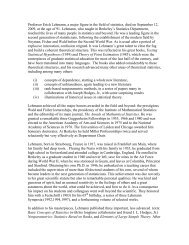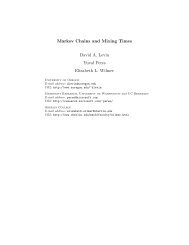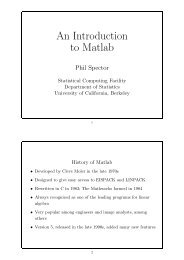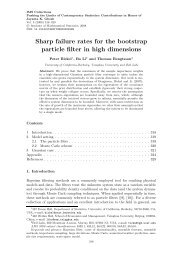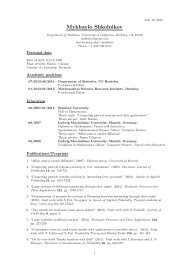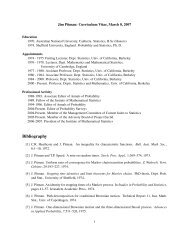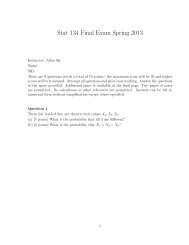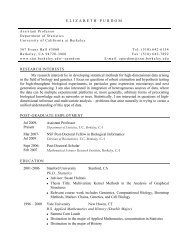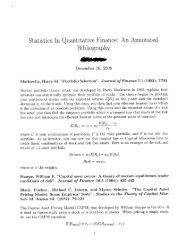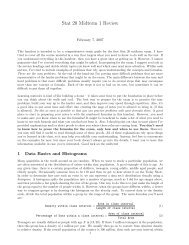Feller Processes and Semigroups
Feller Processes and Semigroups
Feller Processes and Semigroups
Create successful ePaper yourself
Turn your PDF publications into a flip-book with our unique Google optimized e-Paper software.
<strong>Feller</strong> <strong>Processes</strong> <strong>and</strong> <strong>Semigroups</strong> 3<br />
And you will see among the two conditions required for <strong>Feller</strong> semigroup, here this example doesn’t satisfy<br />
(F 1 ).<br />
In fact, (F 2 ) is guaranteed by right continuous path; for (F 1 ), if we let f(x) to be a pseudo-indicator, i.e. be<br />
1 on [a, b], be 0 on (−∞, 0] ∪ [a + b, ∞), <strong>and</strong> be connected continuously on the gaps, here a, b > 0. Then by<br />
definition, T t f(x) = E x f(X t ), notice when x ≠ 0, X t ∼ N(x, t), so T t f(x) changes continuously <strong>and</strong> reaches<br />
maximum at x = (a + b)/2; but when x = 0, T t f(0) = E 0 f(X t ) = f(0) = 0. Thus T t f(x) is not continuous<br />
(at 0).<br />
The answer for both questions is <strong>Feller</strong> semigroup:<br />
Definition 27.3 (<strong>Feller</strong> semigroup). Let S to be a locally compact, separable metric space; C 0 := C 0 (S)<br />
to be all the continuous functions f : S → R <strong>and</strong> f(x) → 0 when x → ∞.(Notice C 0 is a Banach space given<br />
||f|| = sup x |f(x)|.)<br />
A semigroup of positive contraction linear operator T t , t ≥ 0 on C 0 is called <strong>Feller</strong> semigroup if it has the<br />
following regularity conditions:<br />
(F 1 ) T t C 0 ⊂ C 0 , t ≥ 0;<br />
(F 2 ) T t f(x) → f(x), t ↓ 0, ∀ f ∈ C 0 , x ∈ S.<br />
Remark. In fact, (F 1 ) + (F 2 ) + semigroup property ⇒ (F 3 ) ||T t f − f|| → 0, t ↓ 0, ∀ f ∈ C 0 (strong<br />
continuity).<br />
• How to find a nice Markov process associated with a <strong>Feller</strong> semigroup?<br />
In order to get probability kernels, we may need (T t ) to be conservative.<br />
Definition 27.4 (conservative). T is conservative if ∀ x ∈ S, sup f≤1 T f(x) = 1<br />
But in many cases, the (T t ) we know may not be conservative, for example, the particles may die out or<br />
disappear suddenly, while the following compactification may help:<br />
Ŝ := S ∪ {∆} is the one-point compactification of S. ∆ is usually called ”cemetry”, it can be treated as<br />
point at infinite. Ĉ := C(Ŝ) is the set of continuous functions on Ŝ.<br />
Remark. ∀ f ∈ C 0 , f has a continuous extension to Ŝ by letting f(∆) = 0.<br />
Now, we can define a new <strong>Feller</strong> semigroup ˆT t , t ≥ 0 on Ĉ which is conservative.<br />
Lemma 27.5 (compactification). Any <strong>Feller</strong> semigroup T t , t ≥ 0 on C 0 admits an extension to a conservative<br />
<strong>Feller</strong> semigroup ˆT t , t ≥ 0 on Ĉ by letting<br />
ˆT t f := f(∆) + T t (f − f(∆))<br />
t ≥ 0, f ∈ Ĉ<br />
Proof. The only point needing some proof is the positivity: for any f ∈ Ĉ ≥ 0, let g := f(∆) − f. Since<br />
g ≤ f(∆), we have<br />
T t g ≤ T t g + ≤ ||g + || ≤ f(∆)<br />
so ˆT t f = f(∆) − T t g ≥ 0.<br />
To see the contraction <strong>and</strong> conservation, just notice ˆT 1 = 1. To verify the <strong>Feller</strong> semigroup property:<br />
(F 1 ): ∀ f ∈ Ĉ, ˆT t f = f(∆) + T t (f − f(∆)) ∈ Ĉ, since T tg ∈ C 0 ;<br />
(F 2 ): || ˆT t f − f|| = ||T t g − g|| → 0, t ↓ 0, since g ∈ C 0 .



